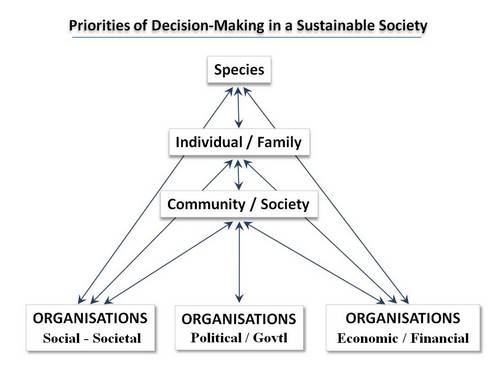A caution is advised: When considering the development of a sustainable Christian religion and sustainable church organizations, it is vital that one not be confused with the other in order for each to stay true to their separate functions. They are distinctly different from each other, though sharing common values and interests. The religion OF Jesus is based on a belief system that will endure for millennia with or without a man made organization. The challenge here is to design a socially sustainable church organization that has the capability of remaining in existence as an effective and functional organization, not because of the religious faith of its followers, but because it was designed to be self-sustaining.
Societies and communities are not organizational entities, but amorphous aggregates of organizations and groups of people. Because of that, attempts to move a society toward socially sustainability will fail until organizations become invested in the values of sustainability as the criteria for their decision-making.
The illustration below describes the social symbiosis that develops in communities and societies that have chosen to move toward social sustainability. The most powerful organizations are those within the three pillars of a functional society: Social-societal, (where church organizations exist), political-governmental, and economic-financial.

The illustration points to those organizations within the three pillars as the primary elements that sustain the community/society, individual/family. In other words, without functional organizations, which includes all church organizations, communities and societies will eventually decline and collapse. Historically, this relationship has never been recognized as a necessary element of the relationship between organizations and the individual/family. When we have become conscious of their mutual dependency to sustain their mutual existence, then we have begun to recognize their socially sustainable symbiotic relationship.
Sustaining a conscious and intentional symbiotic relationship of social, political, and financial organizations is vital to sustain a democratic nation. A society that wants and needs to continue its existence into future centuries, i.e., to become socially sustainable, organizations within those three pillars have a socially sustainable moral obligation to uphold their side of that relationship.
This is a highly foresightful relationship. When we see the holism of our personal, familial, social, and organizational existence, we have come a long way to understand that maintaining and sustaining this symbiotic relationship will sustain all future generations of families, businesses, churches, and community governments with an assurance that their existence will be stable, peaceful, and organized so that they enjoy the pattern and order of a socially sustainable nation.
Historically, church organizations have simply relied upon religious beliefs as sufficient to convince the individual and families to come to church in order to achieve a better life and to assure their “reward in heaven.” That simple marketing tactic is no longer effective. What has been missing from Christianity and related forms of belief is a strategic multi-century marketing plan that places the church organization as the most relevant social institution, except for the family, in the lives of believers in their community. The church organization, as an inclusive organization of a community, has a far heavier moral burden than a hardware store, for example.
In every society, the church organization has a social moral obligation to help improve the social environment of the community that will enable future generations to become more socially conscious to make proactive ethical and moral decisions.
By installing an inclusive Clinic for Sustainable Families within the church organization, to train parents how to become more effective parents and to enculturate their children as socially capable, competent, and responsible individuals, the church will empower those parents and their children to provide a “multiplier effect” for increasing civility, benevolence, and generosity within their community. This enduring strategic marketing plan would need to incorporate the Clinics as a multi-generational service-delivery system that improves the quality of life of the individual and families while also providing for their spiritual growth and enlightenment. Doing so will assure churches with a perennial audience with each new generation. They will have a very positive, cumulative effect in their community for centuries to come.
The church organization’s social, moral, and spiritual responsibilities include more than just teaching and training believers how to save their soul. Its moral responsibility is also to work to “save the soul” of their local community and society. Doing so provides a much more positive and constructive social environment for all next generations. By teaching and training parents and children in every generation, the community and larger society will in effect also become enculturated with the best practices of parenting, child rearing, social responsibilities, and social justice.
What bonds the religion, church organization, and the Clinics together are the seven values that have sustained our species. When those values become the values for decision-making in church organizations, they will be able to adapt their functions to the needs of the individual/family, community, and society. When a church organization sees itself as a member of the major pillar of a functional society, as illustrated above, then their short term goals and long term mission become easily aligned.
